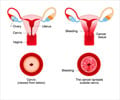The AI model from IASST boasts a 98.02% accuracy, significantly improving early detection of cervical dysplasia.
- An AI model with a 98.02% accuracy rate for diagnosing cervical dysplasia has been developed by IASST scientists
- The model uses the Non-Subsampled Contourlet Transform and YCbCr colour model to enhance diagnostic precision
- This advancement could lead to earlier and more reliable identification of cervical dysplasia, improving treatment outcomes
Novel computational model could help early detection of cervical cancer
Go to source). The disorder is characterized by abnormal cell development on the cervix's surface and has the potential to lead to cervical cancer. The work, published in the journal Mathematics, emphasized the significance of accurate pattern identification and categorization in the diagnosis and treatment of cervical cell dysplasia. "Our goal was to create a model that not only offers unparalleled accuracy but also operates efficiently with minimal computational resources," explained Dr. Lipi B. Mahanta of the IASST.
Cervical dysplasia, if detected early, can be treated before it progresses to cervical cancer. Cutting-edge AI models are now making early detection more accurate than ever! #medicalinnovation #aiinhealthcare #medindia’
Machine Learning Framework for Cervical Dysplasia Diagnosis
The team's comprehensive approach included experimenting with multiple color models, transformation approaches, feature representation schemes, and classification methods to optimize the machine learning (ML) framework they created. The study includes testing the model's performance on two datasets: one sourced from healthcare centers across India and another publicly available dataset.The model attained an amazing average accuracy rate of 98.02% by using the Non-Subsampled Contourlet Transform (NSCT) and the YCbCr colour model, a specialized method of encoding colours in images. This high level of accuracy demonstrates the model's potential as a transformational tool in medical diagnostics.
Early Detection of Cervical Dysplasia
"Our findings could lead to significant advancements in the early detection of cervical dysplasia, providing healthcare professionals with more accurate diagnostic tools," according to Dr. Mahanta.The discovery is likely to improve diagnostic accuracy and treatment outcomes for women at risk of cervical cancer. The development of this model represents a tremendous advancement in medical science, providing fresh hope for early and reliable identification of cervical dysplasia.
Reference:
- Novel computational model could help early detection of cervical cancer (https://pib.gov.in/PressReleasePage.aspx?PRID=2036843)
















